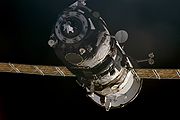
Progress-M1
Encyclopedia
Progress-M1 also known as Progress 7K-TGM1, is a Russia
n spacecraft which is used to resupply space station
s. It is a variant of the Progress spacecraft, derived from the Progress-M
, but modified to carry more propellent for refuelling the space station instead of other cargoes such as water. A Progress M1 11F615A55 spacecraft could carry 1700 kilograms (3,747.9 lb) of propellent, compared to the 850 kilograms (1,873.9 lb) that a Progress-M of the same generation could carry.
 The Progress-M1 11F615A70 is a modernised variant of the earlier 11F615A55, with digital flight control systems replacing the earlier analogue ones. The older 11F615A55 spacecraft is no longer in use. It made eleven flights, the last of which, Progress M1-11
The Progress-M1 11F615A70 is a modernised variant of the earlier 11F615A55, with digital flight control systems replacing the earlier analogue ones. The older 11F615A55 spacecraft is no longer in use. It made eleven flights, the last of which, Progress M1-11
, was deorbited in June 2004. The 11F615A70 is scheduled to make its first flight, Progress M1-01M, in 2011.
Of the eleven 11F615A55 spacecraft launched, three flew to Mir
, with the remainder being used to resupply the International Space Station
. Ten of the spacecraft were used for traditional resupply missions, whilst the eleventh, Progress M1-5
, was used instead to deorbit the Mir space station.
Progress-M1 spacecraft are launched by Soyuz rockets. Eight of the 11F615A55 spacecraft were launched by the Soyuz-U
variant, whilst the remaining three; the sixth
, seventh
and ninth
spacecraft, flew on the Soyuz-FG
. 11F615A70 launches are expected to use the Soyuz-2.
Russia
Russia or , officially known as both Russia and the Russian Federation , is a country in northern Eurasia. It is a federal semi-presidential republic, comprising 83 federal subjects...
n spacecraft which is used to resupply space station
Space station
A space station is a spacecraft capable of supporting a crew which is designed to remain in space for an extended period of time, and to which other spacecraft can dock. A space station is distinguished from other spacecraft used for human spaceflight by its lack of major propulsion or landing...
s. It is a variant of the Progress spacecraft, derived from the Progress-M
Progress-M
Progress-M , also known as Progress 7K-TGM, is a Russian, previously Soviet spacecraft which is used to resupply space stations. It is a variant of the Progress spacecraft, originally built in the late 1980s as a modernised version of the Progress 7K-TG spacecraft, using new systems developed for...
, but modified to carry more propellent for refuelling the space station instead of other cargoes such as water. A Progress M1 11F615A55 spacecraft could carry 1700 kilograms (3,747.9 lb) of propellent, compared to the 850 kilograms (1,873.9 lb) that a Progress-M of the same generation could carry.

Progress M1-11
Progress M1-11, identified by NASA as Progress 13 or 13P, was a Progress spacecraft used to resupply the International Space Station. It was a Progress-M1 11F615A55 spacecraft, with the serial number 260....
, was deorbited in June 2004. The 11F615A70 is scheduled to make its first flight, Progress M1-01M, in 2011.
Of the eleven 11F615A55 spacecraft launched, three flew to Mir
Mir
Mir was a space station operated in low Earth orbit from 1986 to 2001, at first by the Soviet Union and then by Russia. Assembled in orbit from 1986 to 1996, Mir was the first modular space station and had a greater mass than that of any previous spacecraft, holding the record for the...
, with the remainder being used to resupply the International Space Station
International Space Station
The International Space Station is a habitable, artificial satellite in low Earth orbit. The ISS follows the Salyut, Almaz, Cosmos, Skylab, and Mir space stations, as the 11th space station launched, not including the Genesis I and II prototypes...
. Ten of the spacecraft were used for traditional resupply missions, whilst the eleventh, Progress M1-5
Progress M1-5
Progress M1-5 was the Progress spacecraft which was launched by Russia in 2001 to deorbit the fifteen-year old Mir space station before it naturally fell from orbit, potentially landing in a populated area...
, was used instead to deorbit the Mir space station.
Progress-M1 spacecraft are launched by Soyuz rockets. Eight of the 11F615A55 spacecraft were launched by the Soyuz-U
Soyuz-U
The Soyuz-U launch vehicle is an improved version of the original Soyuz LV. Soyuz-U is part of the R-7 family of rockets based on the R-7 Semyorka missile. Members of this rocket family were designed by the TsSKB design bureau and constructed at the Progress Factory in Samara, Russia....
variant, whilst the remaining three; the sixth
Progress M1-6
Progress M1-6, identified by NASA as Progress 4 or 4P, was a Progress spacecraft used to resupply the International Space Station. It was a Progress-M1 11F615A55 spacecraft, with the serial number 255....
, seventh
Progress M1-7
Progress M1-7, identified by NASA as Progress 6 or 6P, was a Progress spacecraft used to resupply the International Space Station. It was a Progress-M1 11F615A55 spacecraft, with the serial number 256....
and ninth
Progress M1-9
Progress M1-9, identified by NASA as Progress 9 or 9P, was a Progress spacecraft used to resupply the International Space Station. It was a Progress-M1 11F615A55 spacecraft, with the serial number 258....
spacecraft, flew on the Soyuz-FG
Soyuz-FG
The Soyuz-FG launch vehicle is an improved version of the Soyuz-U, from the R-7 family of rockets, designed and constructed by TsSKB-Progress in Samara...
. 11F615A70 launches are expected to use the Soyuz-2.

